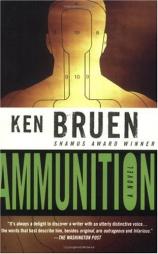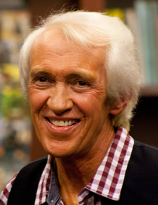Ammunition
Review
Ammunition
Ireland is known for producing some of the greatest writers in
Western literature. But few would consider Joyce or Yeats or Shaw
to be mystery or crime writers. The prolific Galway writer, Ken
Bruen, is an award-winning mystery author who has been called the
“Celtic Dashiell Hammett.” Bruen is changing the way
Americans think about Irish writers by producing some of the best
mysteries on the market today.
AMMUNITION is the seventh entry in Bruen’s police procedural
series set in London. It does not disappoint. Bruen continues to
take the procedural format made famous by Ed McBain in his 87th
Precinct series and turn it on its ear. The result is a
delightful book that is impossible to put down. This is a story
about cold-blooded murder, vigilante violence, illicit drug use,
law breaking, backbiting and hatred in South East London. And
that’s just among the cops.
The novel starts with the attempted assassination of the most
famous cop in the Met, the totally amoral and often brutal Sergeant
Brant, who is referred to by both friends and foes alike as
“an animal” or “the devil.” When word
spreads that he has been shot, the first reaction by all is the
same: “Is he dead?” This is followed by disappointed
silence when they hear the answer. Besides cops, those arriving at
the hospital to stand vigil for Brant include “a whole gaggle
of them (hookers).”
Brant is that type of guy. His closest thing to a friend on the
force, Porter Nash, the gay diabetic, is assigned to find the
shooter. Nash realizes: “Thing was, almost every single case,
with Brant’s unique style of policing, gave rise to a
suspect. It was fast becoming…who wouldn’t want to
shoot him?”
To make matters worse, Brant’s assailant takes to calling
harried Chief Inspector Roberts, taunting him and promising to do
the job right the next time. And a new sick social phenomena known
as “Happy Slapping” plagues London’s streets.
Youngsters walk up to strangers, slap them across the face and
record their stunned reaction on a cell phone. The results end up
on the Internet.
Newly promoted Sergeant Falls is ordered to go down to Kennington
and catch a "happy slapper." As the Metropolitan’s sole black
female cop, Falls is widely hated not for her gender or race but
for her past screwups as a cop. And it turns out she passed the
sergeant’s exam on her final shot with the help of Brant, who
stole the exam for her. But Fall’s past is about to catch up
with her, big time.
Bruen writes of Falls: “The past was not so much another
country as a minefield of horror.” A big part of that horror
is a “nasty, psycho” serial killer named Angie, with
whom Falls once had a brief lesbian fling. Needless to say, Angie
could bring her world crashing down in an instant. And now Angie is
somehow out of prison and stalking Falls.
Then there is disgraced Constable McDonald, bitter, drug-addled and
stuck guarding a shopping center in the freezing cold. When he
randomly bloodies a defiant teen, McDonald comes to the attention
of a group of elderly vigilantes looking to take back their
neighborhood from street hoodlums.
As if all this were not enough chaos, there appears on the scene a
Yank. He is L.M. Wallace, a “terrorism expert” sent by
American officials to assist the London police in looking for
bombers. In Wallace, Bruen has created a character every bit as
dangerous as Brant on his worst day. Wallace is a “dark
side” figure who would scare the daylights out of Dick
Cheney.
And, of course, there is still the somewhat shaken Brant, who makes
a miraculous and quick recovery from his wounds. Bruen writes of
Brant: “Yeah, fine, he was of Irish descent, he knew the
painkiller that never failed. Tore open his drinks cabinet, nigh
splintering the wood, grabbed the bottle of Jameson, a twenty-five
year old beauty he’d been saving, twisted off the cap as if
he was twisting the neck of some bugger, got a lethal measure
poured into a heavy Waterford tumbler and drank deep, waiting for
the magic to light his belly.” And that, along with the help
of one of his hooker friends, put Brant right back in the game. As
Nash observes, “A focused Brant was a very dangerous
animal.”
Bruen moves the various plot lines along at a brisk pace. Much like
the master of the procedural, McBain, Bruen can make his characters
become so involved in another plot line that they forget
momentarily the danger they face in their own. And like McBain, he
can make you laugh at human foibles and absurdity one moment and
then bring you right back into the random terror of modern life the
next. Bruen writes of one character, unjustly set up by Falls:
“He’d been walking along, his mind preoccupied by minor
irritations. Oh, God, what he wouldn’t give to have them
back…Then f---, like hell opened up and Armageddon hit
him.”
This is a perfect description of noir. Bruen is a master of noir,
taking that very American genre and putting a unique Irish twist on
it. Books like AMMUNITION are quick, fun reads, excursions to the
dark side of the street. If you haven’t read them, then
search out the entire series.
In true noir tradition these books have something to say about the
modern world. They tell us that things are rarely what they seem on
the surface. And at the end of the day, the world often contains
more gray than black and white. Occasionally, AMMUNITION points
out, the darkness wins out and the bullets find their target. But
the struggle never ends.
Reviewed by Tom Callahan on December 22, 2010





